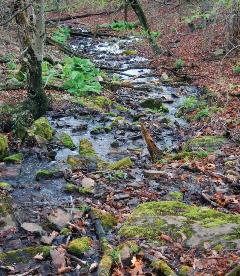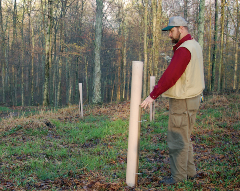Johns Creek in Craig County, Virginia, is part of the James River and Chesapeake Bay Watershed and means a great deal to me. As a teenager in the 1960s, I was among a group of high school students who helped fight (and defeat) the U.S. Army Corps of Engineers’ proposed channelization of the mountain rill.
In 1969, I went camping for the first time in my life along a stretch of Johns Creek. In 1977, on that same stretch, I took a girl named Elaine Adams (during our fourth date) fishing there. In 1984, Elaine, by then my wife of six years, and I bought that same 30-acre parcel.
Sometime later we discovered how special the property is in terms of clean water and wildlife, which is one of many reasons why we placed a conservation easement on the land. In case Ikes are unfamiliar with the term, conservation easements are voluntary, permanent, legal agreements that protect land from development and maintain its conservation values. Two particularly important conservation values are clean water and riparian zone (that crucial transitional habitat between land and water) protection.
Elaine and I like to think that the conservation easement, which prohibits the destruction or harm of the vernal pool (seasonal wetland), intermittent stream and headwater spring, is our way of protecting the peepers, game and non-game animals and mussels that live there and downstream.
Most years, a vernal pool appears in the main woodlot. Several species of frogs and salamanders depend on the property as breeding grounds. The chirping of spring peepers is especially wonderful to behold as these tiny tree frogs with an X on their backs are quite the songsters. The pool feeds into an intermittent stream that leads to the creek itself, which flows through our land on its way to Craig Creek, the James River and the Chesapeake Bay.
 Headwater springs, like this one on the author's land in Craig County, Virginia, are crucial to our country's fisheries, water supply and wildlife.
Headwater springs, like this one on the author's land in Craig County, Virginia, are crucial to our country's fisheries, water supply and wildlife.
Halfway along the seasonal stream lies a headwater spring of the James River. In this spring, there is a dip in the terrain that creates a natural funnel that flows past a tree stand where, on opening day of Virginia’s bow season, I often arrow a white-tailed deer. Johns Creek itself is home to the endangered James River spiny mussel. We also believe that our conservation easement (and its protection of all the land’s water sources) plays a role in helping to increase the number of mussels.
David Perry, director of the Blue Ridge Land Conservancy (BRLC) – the land trust that helped us put an easement on the land – agrees. “The little things that we do upstream to protect water has a watershed-wide effect for everyone, everything downstream,” he said. “That’s one of the things we try to emphasize when our staff talk to landowners, student groups, and the general public about the benefits of conservation easements. Easements can help lead to better fishing, a better water supply and healthier landscapes.”
And now, more than at any other time since the Clean Water Act passed in 1972, the conservation values of clean water are under attack. Under final regulations of the current administration, prairie potholes, vernal pools, and other isolated wetlands, as well as ephemeral streams, are losing their protections under the Clean Water Act. Through promoting conservation easements, individual Ikes can make a difference in the areas where we live, fish, hunt and enjoy nature.
Spreading the Word About Easements
Through the years, I’ve promoted conservation easements at fishing shows, library talks, meetings of conservation organizations, and, of course, at Ike chapter gatherings. But by far the most effective way to tout easements is through individual contact with landowners.
Perry further explains, “Our staff conduct group meetings about easements and visit farms to talk to landowners face-to-face, but from our experience, the most effective means of outreach is neighbor-to-neighbor, as in a person telling his friend down the road how a conservation easement has been a positive for his land.”
Any Ike who hunts, fishes or enjoys other outdoor pursuits on private land can serve as an advocate for conservation easements. I often tell landowners that they can preserve the rural heritage of their land, protect wildlife habitat and even reduce their tax burden if they go the conservation easement route.
Inspiring Others
Through outreach, individual Ikes can inspire others. My mentor for this inspiration was Ned Yost, an elderly gentleman who once told me that his goal was to turn the headwaters of Virginia’s North Fork of the Roanoke River green on a map – his term for easements. Tamara Vance, a recently retired deputy director of easements for the Virginia Outdoors Foundation (VOF), comments that Yost was one of a small group of people that individually advocated for easements to their fellow landowners. The result was that the VOF now has 4,360 acres under easement in this region. Vance also says that the North Fork is a public water supply for the Roanoke metro area and home to the federally listed endangered Roanoke logperch. Yes, a few people – a few Ikes – can make a difference on a watershed.
Last Words
 Tree tubes within a regenerating riparian zone are often signs of a conservation easement.
Tree tubes within a regenerating riparian zone are often signs of a conservation easement.
Meagan Cupka, assistant director of the BRLC, believes it’s often easy to tell whether a rural property has an easement on it or not. “Many times, land under a conservation easement will display either a lush riparian zone or a regenerating zone with young saplings growing out of those green tree protection tubes,” she said. “On land not under an easement, too many times you’ll see cattle standing in a creek next to an eroding bare bank that has lost all its vegetation.”
This spring, I hunted turkeys on our Johns Creek land. This summer, Elaine and I will gather wild blackberries, fish and bird watch there. Come fall, our son-in-law and I will bow hunt on the land and, in late winter, we’ll revel in the wonders of the vernal pool. And in every season, we’ll be doing our part to protect America’s clean water.